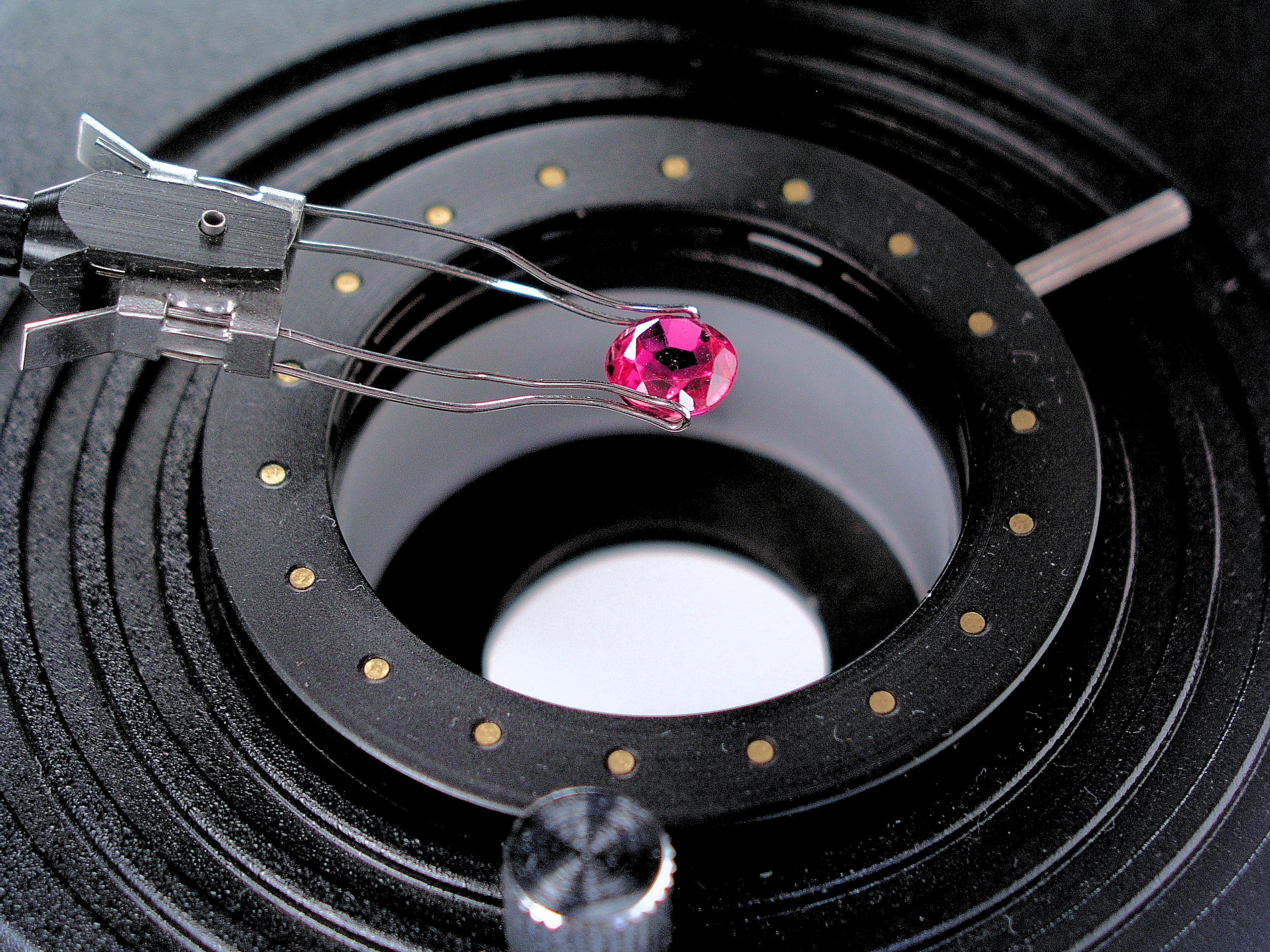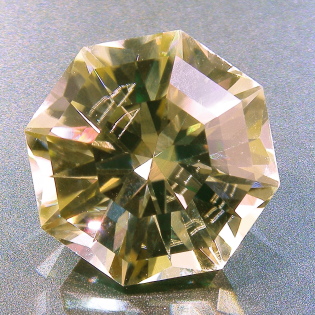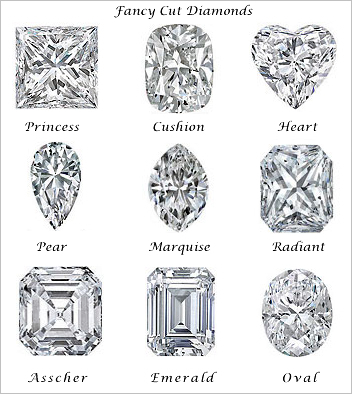|
Culet
{{inline, date=November 2022 In gemology, a culet is a flat face on the bottom of a gemstone. During the 14th century, after the adoption of the table cut, a further facet was added to the bottom of the cut parallel to the surface of the table. The term used for these bottom facets derives from the Latin word for bottom, ''culus''. The culet is added largely to protect the integrity of the gemstone. On a diamond, the cleavage plane runs parallel to the octahedral faces, and so any damage to the tip of the diamond could cause a split up the entire length of the pavilion. With other gemstones that are not subject to cleavage, the culet is added to protect the fragility of the pointed tip. The culet has remained optional on many diamond cuts up to the present day, and was omitted from Marcel Tolkowsky's original designs for the round brilliant A brilliant is a diamond or other gemstone cut in a particular form with numerous facets so as to have exceptional brilliance. T ... [...More Info...] [...Related Items...] OR: [Wikipedia] [Google] [Baidu] |
Gemology
Gemology or gemmology is the science dealing with natural and artificial gemstone materials. It is a geoscience and a branch of mineralogy. Some jewelers (and many non-jewelers) are academically trained gemologists and are qualified to identify and evaluate gems. History Rudimentary education in gemology for jewellers and gemologists began in the nineteenth century, but the first qualifications were instigated after the National Association of Goldsmiths of Great Britain (NAG) set up a Gemmological Committee for this purpose in 1908. This committee matured into the Gemmological Association of Great Britain (also known as Gem-A), now an educational charity and accredited awarding body with its courses taught worldwide. The first US graduate of Gem-A's diploma course, in 1929, was Robert Shipley, who later established both the Gemological Institute of America and the American Gem Society. There are now several professional schools and associations of gemologists and certificatio ... [...More Info...] [...Related Items...] OR: [Wikipedia] [Google] [Baidu] |
Gemstone
A gemstone (also called a fine gem, jewel, precious stone, or semiprecious stone) is a piece of mineral crystal which, in cut and polished form, is used to make jewelry or other adornments. However, certain rocks (such as lapis lazuli, opal, and obsidian) and occasionally organic materials that are not minerals (such as amber, jet, and pearl) are also used for jewelry and are therefore often considered to be gemstones as well. Most gemstones are hard, but some soft minerals are used in jewelry because of their luster or other physical properties that have aesthetic value. Rarity and notoriety are other characteristics that lend value to gemstones. Apart from jewelry, from earliest antiquity engraved gems and hardstone carvings, such as cups, were major luxury art forms. A gem expert is a gemologist, a gem maker is called a lapidarist or gemcutter; a diamond cutter is called a diamantaire. Characteristics and classification The traditional classification in the West, wh ... [...More Info...] [...Related Items...] OR: [Wikipedia] [Google] [Baidu] |
Diamond Facets
Diamond is a solid form of the element carbon with its atoms arranged in a crystal structure called diamond cubic. Another solid form of carbon known as graphite is the chemically stable form of carbon at room temperature and pressure, but diamond is metastable and converts to it at a negligible rate under those conditions. Diamond has the highest hardness and thermal conductivity of any natural material, properties that are used in major industrial applications such as cutting and polishing tools. They are also the reason that diamond anvil cells can subject materials to pressures found deep in the Earth. Because the arrangement of atoms in diamond is extremely rigid, few types of impurity can contaminate it (two exceptions are boron and nitrogen). Small numbers of defects or impurities (about one per million of lattice atoms) color diamond blue (boron), yellow (nitrogen), brown (defects), green (radiation exposure), purple, pink, orange, or red. Diamond also has a ver ... [...More Info...] [...Related Items...] OR: [Wikipedia] [Google] [Baidu] |
Diamond Cutting
Diamond cutting is the practice of shaping a diamond from a rough stone into a faceted gem. Cutting diamonds requires specialized knowledge, tools, equipment, and techniques because of its extreme difficulty. The first guild of diamond cutters and polishers (Diamantaire) was formed in 1375 in Nuremberg, Germany, and led to the development of various types of "cut". This has two meanings in relation to diamonds. The first is the shape: square, oval, and so on. The second relates to the specific quality of cut within the shape, and the quality and price will vary greatly based on the cut quality. Since diamonds are one of the hardest materials, special diamond-coated surfaces are used to grind the diamond down. The first major development in diamond cutting came with the "Point Cut" during the later half of the 14th century: the Point Cut follows the natural shape of an octahedral rough diamond crystal, eliminating some waste in the cutting process. Diamond cutting, as well as overa ... [...More Info...] [...Related Items...] OR: [Wikipedia] [Google] [Baidu] |
Facet
Facets () are flat faces on geometric shapes. The organization of naturally occurring facets was key to early developments in crystallography, since they reflect the underlying symmetry of the crystal structure. Gemstones commonly have facets cut into them in order to improve their appearance by allowing them to reflect light. Facet arrangements Of the hundreds of facet arrangements that have been used, the most famous is probably the round brilliant cut, used for diamond and many colored gemstones. This first early version of what would become the modern Brilliant Cut is said to have been devised by an Italian named Peruzzi, sometime in the late 17th century.Gems, 5th edition, Webster, 1995.Gemstones of the world, Schumann, 1977. Later on, the first angles for an "ideal" cut diamond were calculated by Marcel Tolkowsky in 1919. Slight modifications have been made since then, but angles for "ideal" cut diamonds are still similar to Tolkowsky's formula. Round brilliants cut befo ... [...More Info...] [...Related Items...] OR: [Wikipedia] [Google] [Baidu] |
Latin
Latin (, or , ) is a classical language belonging to the Italic branch of the Indo-European languages. Latin was originally a dialect spoken in the lower Tiber area (then known as Latium) around present-day Rome, but through the power of the Roman Republic it became the dominant language in the Italian region and subsequently throughout the Roman Empire. Even after the fall of Western Rome, Latin remained the common language of international communication, science, scholarship and academia in Europe until well into the 18th century, when other regional vernaculars (including its own descendants, the Romance languages) supplanted it in common academic and political usage, and it eventually became a dead language in the modern linguistic definition. Latin is a highly inflected language, with three distinct genders (masculine, feminine, and neuter), six or seven noun cases (nominative, accusative, genitive, dative, ablative, and vocative), five declensions, four verb conjuga ... [...More Info...] [...Related Items...] OR: [Wikipedia] [Google] [Baidu] |
Bottom (other)
Bottom may refer to: Anatomy and sex * Bottom (BDSM), the partner in a BDSM who takes the passive, receiving, or obedient role, to that of the top or dominant * Bottom (sex), a term used by gay couples and BDSM * Buttocks or bottom, part of the anatomy on the posterior of the pelvic region of apes and humans, and many other bipeds or quadrupeds Arts, entertainment, and media * ''Bottom'' (TV series), a British sitcom and stage show * "Bottom", a song by Puddle of Mudd from '' Life On Display'' * "Bottom", a song by Tool from '' Undertow'' * Nick Bottom, a character from Shakespeare's ''A Midsummer Night's Dream'' * ''The Bottoms'' (novel), a 2000 novel by Joe R. Lansdale * ''Bottoms'', a 1966 film by Yoko Ono Geography * Bottom (valley), the floor of a valley ** List of geographical bottoms, list of geographical features called "bottom" * Bottomland (freshwater ecology), low-lying alluvial land adjacent to a river *Foggy Bottom, a neighborhood in Washington, D.C. * L ... [...More Info...] [...Related Items...] OR: [Wikipedia] [Google] [Baidu] |
Cleavage (crystal)
Cleavage, in mineralogy and materials science, is the tendency of crystalline materials to split along definite crystallographic structural planes. These planes of relative weakness are a result of the regular locations of atoms and ions in the crystal, which create smooth repeating surfaces that are visible both in the microscope and to the naked eye. If bonds in certain directions are weaker than others, the crystal will tend to split along the weakly bonded planes. These flat breaks are termed "cleavage."Hurlbut, Cornelius S.; Klein, Cornelis, 1985, '' Manual of Mineralogy'', 20th ed., Wiley, The classic example of cleavage is mica, which cleaves in a single direction along the basal pinacoid, making the layers seem like pages in a book. In fact, mineralogists often refer to "books of mica." Diamond and graphite provide examples of cleavage. Both are composed solely of a single element, carbon. But in diamond, each carbon atom is bonded to four others in a tetrahedral pa ... [...More Info...] [...Related Items...] OR: [Wikipedia] [Google] [Baidu] |
Parallel (geometry)
In geometry, parallel lines are coplanar straight lines that do not intersect at any point. Parallel planes are planes in the same three-dimensional space that never meet. ''Parallel curves'' are curves that do not touch each other or intersect and keep a fixed minimum distance. In three-dimensional Euclidean space, a line and a plane that do not share a point are also said to be parallel. However, two noncoplanar lines are called ''skew lines''. Parallel lines are the subject of Euclid's parallel postulate. Parallelism is primarily a property of affine geometries and Euclidean geometry is a special instance of this type of geometry. In some other geometries, such as hyperbolic geometry, lines can have analogous properties that are referred to as parallelism. Symbol The parallel symbol is \parallel. For example, AB \parallel CD indicates that line ''AB'' is parallel to line ''CD''. In the Unicode character set, the "parallel" and "not parallel" signs have codepoint ... [...More Info...] [...Related Items...] OR: [Wikipedia] [Google] [Baidu] |
Octahedron
In geometry, an octahedron (plural: octahedra, octahedrons) is a polyhedron with eight faces. The term is most commonly used to refer to the regular octahedron, a Platonic solid composed of eight equilateral triangles, four of which meet at each vertex. A regular octahedron is the dual polyhedron of a cube. It is a rectified tetrahedron. It is a square bipyramid in any of three orthogonal orientations. It is also a triangular antiprism in any of four orientations. An octahedron is the three-dimensional case of the more general concept of a cross polytope. A regular octahedron is a 3-ball in the Manhattan () metric. Regular octahedron Dimensions If the edge length of a regular octahedron is ''a'', the radius of a circumscribed sphere (one that touches the octahedron at all vertices) is :r_u = \frac a \approx 0.707 \cdot a and the radius of an inscribed sphere (tangent to each of the octahedron's faces) is :r_i = \frac a \approx 0.408\cdot a while the midradius, which ... [...More Info...] [...Related Items...] OR: [Wikipedia] [Google] [Baidu] |
Diamond Cut
A diamond cut is a style or design guide used when shaping a diamond for polishing such as the brilliant cut. Cut does not refer to shape (pear, oval), but the symmetry, proportioning and polish of a diamond. The cut of a diamond greatly affects a diamond's brilliance; this means if it is cut poorly, it will be less luminous. In order to best use a diamond gemstone's material properties, a number of different diamond cuts have been developed. A diamond cut constitutes a more or less symmetrical arrangement of facets, which together modify the shape and appearance of a diamond crystal. Diamond cutters must consider several factors, such as the shape and size of the crystal, when choosing a cut. The practical history of diamond cuts can be traced back to the Middle Ages, while their theoretical basis was not developed until the turn of the 20th century. Design, creation and innovation continue to the present day: new technology—notably laser cutting and computer-aided design— ... [...More Info...] [...Related Items...] OR: [Wikipedia] [Google] [Baidu] |
Marcel Tolkowsky
Marcel Tolkowsky (25 December 1899 – 10 February 1991), Obituary. an engineer by education, was a Belgian member of a Jewish family of diamond cutters from Poland. He is generally acknowledged as the father of the modern round brilliant diamond cut. Many of his family have gone on to become noted diamond cutters, including his cousin Lazare Kaplan and his great-nephew Gabi Tolkowsky. Tolkowsky, as part of his PhD topic at the University of London, systematically studied the grinding of diamonds. Around the same time, in his book ''Diamond Design'', he published the specifications of what would later be called the ''American Standard'' (also known as the ''American Ideal Cut'', ''Tolkowsky cut'', and ''Tolkowsky Brilliant''), which is the diamond-cutting benchmark in North America. It was derived from mathematical calculations that considered both brilliance and fire of the stone. Marcel Tolkowsky found that if a diamond Diamond is a Allotropes of carbon, solid f ... [...More Info...] [...Related Items...] OR: [Wikipedia] [Google] [Baidu] |






.png)
